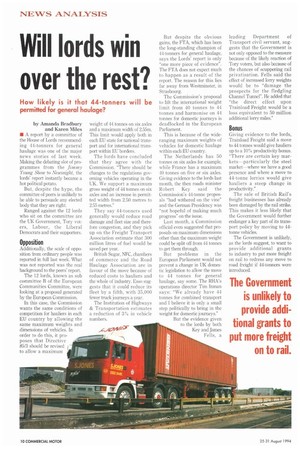Will lords win over the rest.
Page 12

If you've noticed an error in this article please click here to report it so we can fix it.
How likely is it that 44-tonners will be permitted for general haulage?
by Amanda Bradbury and Karen Miles
• A report by a committee of the House of Lords recommending 44-tonners for general haulage was one of the major news stories of last week. Making the debating slot of programmes from the Jimmy Young Show to ATewsn4ght, the lords' report instantly became a hot political potato.
But, despite the hype, the committee of peers is unlikely to be able to persuade any elected body that they are right.
Ranged against the 12 lords who sit on the committee are the UK Government, Tory voters, Labour, the Liberal Democrats and their supporters.
Opposition
Additionally, the scale of opposition from ordinary people was reported in full last week. What was not reported was the real background to the peers' report.
The 12 lords, known as sub committee B of the European Communities Committee, were looking at a proposal generated by the European Commission.
In this case, the Commission wants the same conditions of competition for hauliers in each EU country by allowing the same maximum weights and dimensions of vehicles. In order to do this, it proposes that Directive 85/3 should be revised to allow a maximum weight of 44 tonnes on six axles and a maximum width of 2.55m. This limit would apply both in each EU state for national transport and for international transport within EU borders.
The lords have concluded that they agree with the Commission. "There should be changes to the regulations governing vehicles operating in the UK. We support a maximum gross weight of 44 tonnes on six axles and an increase in permitted width from 2.50 metres to 2.55 metres."
They say 44-formers used generally would reduce road damage and fleet size and therefore congestion, and they pick up on the Freight Transport Association estimate that 300 million litres of fuel would be saved per year.
British Sugar, NFC, chambers of commerce and the Road Haulage Association are in favour of the move because of reduced costs to hauliers and the whole of industry. Esso suggests that it could reduce its fleet by a fifth, with 35,000 fewer truck journeys a year.
The Institution of Highways & Transportation estimates a reduction of 3% in vehicle numbers. But despite the obvious gains, the FTA, which has been the long-standing champion of 99-tonners for general haulage, says the Lords' report is only one more piece of evidence". The HA does not expect much to happen as a result of the report. The reason for this lies far away from Westminster, in Strasbourg.
The Commission's proposal to lift the international weight limit from 40 tonnes to 44 tonnes and harmonise on 44 tonnes for domestic journeys is deadlocked in the European Parliament.
This is because of the wideranging maximum weights of vehicles for domestic haulage within each EU country.
The Netherlands has 50 tonnes on six axles for example, while France has a maximum 90 tonnes on five or six axles. Giving evidence to the lords last month, the then roads minister Robert Key said the Commission's 44-tonne proposals "had withered on the vine" and the German Presidency was "not hopeful of making much progress" on the issue.
Last month, a Commission official even suggested that proposals on maximum dimensions other than the maximum weight could be split off from 44 tonnes to get them through.
But problems in the European Parliament would not prevent a change in UK domestic legislation to allow the move to 44 tonnes for general haulage, say some. The RHA's operations director Tim Inman says: "We already have 44 tonnes for combined transport and I believe it is only a small step politically to bring in the weight for domestic journeys." But the evidence given to the lords by both Key and James Fells, a leading Department of Transport civil servant, suggests that the Government is not only opposed to the measure because of the likely reaction of Tory voters, but also because of the chances of scuppering rail privatisation. Fells said the effect of increased lorry weights would be to "damage the prospects for the fledgling Channel Tunnel". He added that "the direct effect upon Trainload Freight would be a loss equivalent to 50 million additional lorry miles."
Bonus
Giving evidence to the lords, Trainload Freight said a move to 44 tonnes would give hauliers up to a 10% productivity bonus. "There are certain key markets--particularly the steel market—where we have a good presence and where a move to 44-tonne lorries would give hauliers a steep change in productivity."
The sale of British Rail's freight businesses has already been damaged by the rail strike. This makes it less likely that the Government would further endanger a key part of its transport policy by moving to 44tonne vehicles.
The Government is unlikely, as the lords suggest, to want to provide additional grants to industry to put more freight on rail to redress any move to road freight if 44-tonners were introduced.
















































































